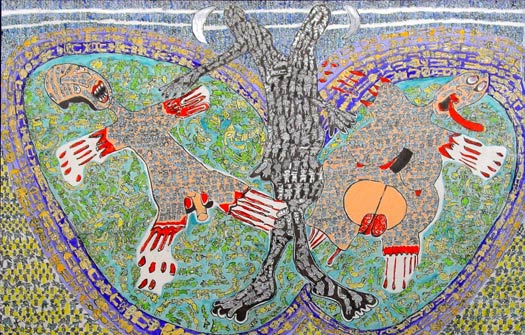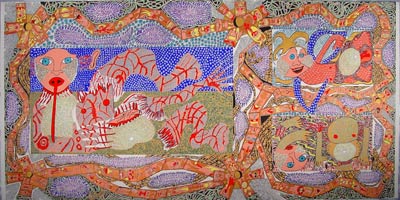by Carol Mason
A new anti-abortion DVD is being distributed on America’s campuses. It is called 180 to suggest that society has turned one hundred and eighty degrees and returned to a time like Hitler’s in which genocide is the order of the day.
| Hypotheticals about killing Jews |
Comparing abortion with the Holocaust, 180 presumes that life begins at conception and that everyone adheres to a particular kind of Christianity even when they say they are not Christian. Director and narrator Ray Comfort, for example, at the beginning of the film announces himself as a Jew and by the evangelizing end of the film is promoting salvation through Jesus Christ. A showcase of interviews with mostly young people in some sunny locale, 180 presents Comfort leading each fresh face through a series of rhetorical questions designed to dead-end in contradiction. It is an exercise in making people say what they hadn’t said before and, realizing the contradiction, feel compelled to second guess themselves.
The DVD is also ostensibly a lament for historical amnesia and youth’s lack of education about world events, namely World War II. After enduring abysmal answers in response to the question “Who was Adolf Hitler?” viewers watch Comfort walk people through contrived scenarios in which they have to choose between saving their own lives or killing Jews.
Stoking Fear and Trauma
Raising the fear of a back-to-the-future situation in which such atrocities may recur because we have forgotten our past, 180 evokes the same fear we see in recent Hollywood films: the fear of having the capacity to forget who we are in the face of trauma. This fear is evident in films like Martin Scorsese’s Shutter Island and Jim Sheridan’s Dream House, which give us main characters who may be unreliable narrators, whose points of view are questionable, and who don’t know if they are killers or victims. These ambiguities reflect an American society whose response to 9/11 entailed ongoing wars, civilian killings, discarding of Geneva Conventions and embracing increasingly authoritarian military and security tactics. The DVD 180 evokes this same fearful uncertainty about being a killer or a victim in the context of abortion. In 180 each of the young men and women interviewed are brought to the conclusion that they might as well be killers if they don’t actively oppose abortion.
Watching college-aged people struggle with Comfort’s moral manipulation can be disheartening or exciting, depending on whether you appreciate voyeurism and the power dynamics of conversion between an older man and his young interviewees. This DVD imagines an audience who sees evangelical confrontations as entertainment and edification. Especially in lingering on Comfort’s extended interview with a young, pretty woman who sports sunglasses and blond braids, 180 positions the viewer as someone watching her succumb to his ways in the guise of civility and higher purpose instead of prurient desire.
The question of civility might arise often because the distribution of 180, like other campus antiabortion crusades, clearly aims to provoke. At the University of Kentucky, a student was handed a copy of 180 after leaving her seminar on the Holocaust.
Any student of the Holocaust would be appalled at the DVD’s parallels of mass graves of Jews with abortion because they know that Hitler’s pronatalism outlawed abortion. Nazi policy increasingly prohibited abortion throughout World War II and imprisoned those who terminated pregnancies. Especially in the context of the hypotheticals about killing Jews, the DVD’s leading question, “So, would you say you value life?” obfuscates Hitler’s complex taxonomy of “life.” For professors familiar with scholarly considerations that delve into different historical and moral iterations of “life itself,” the DVD 180 is bound to strike them as devoid of historical knowledge and as a mockery of philosophical inquiry.
For years universities have been the chosen sites for this kind of inflammatory anti-abortion challenge to historical documentation, fact-based research and critical thinking. What now tours campuses as Justice for All (JFA) first circulated colleges in 1997 as the Genocide Awareness Project. JFA is comprised of huge visual presentations displayed on structures of high-grade vinyl sheeting stretched over two-stories-tall metal framework. They present strewn fetal-and-uterine flesh juxtaposed with hanged, emaciated, tortured, incised or incarcerated bodies of African-Americans, Jews and breast cancer patients. The contentious claims (abortion is genocide of Blacks and Jews, and causes disease in women) are pretense to draw students and faculty into debate, often furious or infuriating. If college administrators tell them to cease and desist these specious confrontations, JFA folds in their huge vinyl panels and advertises that they have been censored, thereby perpetuating a sense of truth being under siege and Christian crusaders being persecuted.
Students Find New Responses
How, then, can people on campus respond without feeding the persecution complex of these Christian missionaries? Spiritual Youth for Reproductive Freedom, an offshoot of the Religious Coalition for Reproductive Choice, developed some effective tools, including templates for letters to the editors of campus newspapers, fact sheets that debunk the comparisons and statements from a variety of religious leaders.
| Contentious claims to draw students into debate |
But it is not enough to match the sheer erasure of context. JFA decontextualizes lynching from Reconstruction, Nazi concentration camps from fascism and breast cancer from environmental toxins (and myriad other, actual, causes) in order to present them in the same category as abortion. JFA stands in defiance of historical knowledge and epidemiological science. It purports, instead, a cultural logic in which unborn children are victims of an evil genocide, with a variety of evil instigators: people of color may see the enemy as whites; white supremacists may see the enemy as Jews; evangelicals may see the enemy as Satan. The JFA barrage of splayed bodies and bloody flesh invokes the powers of horror relevant to multiple viewers, so much so that some find it impossible to walk by to get to their next class.
In Fall 2010 in Oklahoma, a front line for issuing increasingly punitive and regulatory laws in the name of protecting the unborn, students decided to meet cacophony with cacophony. Describing the JFA display as an absurd “fetus carnival,” they opted for a carnivalesque response. Brandishing signs, including tributes to the assassinated abortion provider Dr. George Tiller, handing out fact sheets and blowing on dozens of dime-store noisemakers and kazoos, students held a particularly noisy party-protest near the JFA display, annoying to no end the JFA “counselors,” who were paid to be there. The students refused to engage in dialogue with the JFA employees and instead reclaimed the public space, refusing to play by the rules of a rhetorical set-up. When the JFA couldn’t goad the Oklahoma students into a sham public debate, they tried to gain pity by folding their display in on itself. Especially in Oklahoma, where the Trail of Tears ended and where sterilization abuse precluded a robust reproduction of American Indians, playing fast and loose with the term genocide was a profound affront that would not go unchallenged.
Like the touring panels, Comfort’s 180 DVD has antiabortion film predecessors, too. It is, in part, derived from Francis Schaeffer’s 1979 Whatever Happened to the Human Race, which asserted that abortion superseded slavery and the Holocaust as the worst human atrocity and suggested it is a sign of the Christian “End Times.”
A more recent relative to 180 is Mark Crutcher’s Maafa 21, which presents abortion as black genocide. Both 180 and Maafa 21 are an aggressive response by abortion foes to effective crossracial work by reproductive justice organizations such as SisterSong and National Advocates for Pregnant Women, which use fact-based research to educate communities and combat punitive legislation. The DVD 180 and other antiabortion efforts to play the race card also are responses to important feminist scholarship produced in the last few decades that provides intersectional analyses of America’s eugenic past and pronatalism.
I believe that Ray Comfort’s college-based campaign depicting abortion as Holocaust is a doomed appeal to educated youth who are coming into their own power. As those Oklahoma students demonstrated, contrary to what 180 shows us, the youth of today know their history, claim their space, won’t debate fallacies and can kazoo the fetus carnival out of here. In my mind, the creative rebellion of Oklahoma students runs counter to everyone who writes off Middle America as hopelessly conservative. As one young activist said about the reproductive justice movement in Oklahoma, “the winds sweeping down the plain could be blowing in a new direction” — and it is not, as 180 would purport, backwards.
Carol Mason is Professor of Gender and Women’s Studies at the University of Kentucky and author of “Killing for Life: The Apocalyptic Narrative of Pro-Life Politics.”
Also see: As Access Slides, Feminists Need to “Extract” From Our Self-Help Past by Carol Downer in this edition of On The Issues Magazine
Also see: Letter to a Young Activist: Don’t Drop the Banner by Barbara Santee in this edition of On The Issues Magazine
Read the Cafe for new and updated stories.


